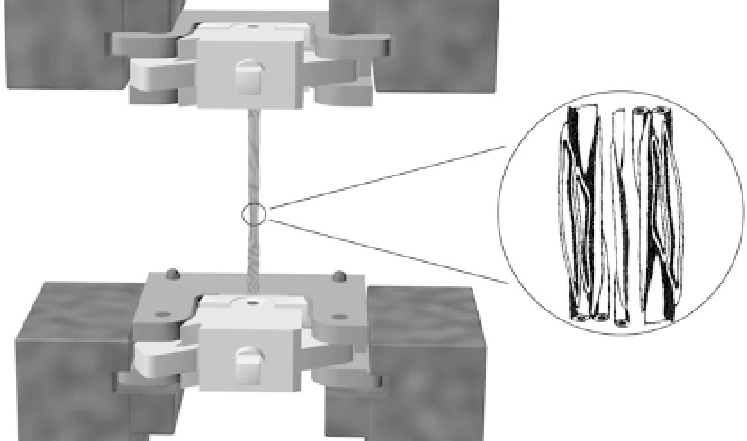Agriculture Reference
In-Depth Information
Fig. 10.7.
A collection of hemp fibre bundle fastened to the Pressley clamp.
means of a laser beam in several places. The
sample is then transferred automatically to the
tensile testing system. After the tensile test
with the desired pre-tension, the sample con-
tainers are removed and the next samples are
tested automatically. Forty-five individual ele-
ments may be prepared in advance and
inserted in the system automatically by auto-
sampler. The software allows both the deter-
mination of surfaces (N/mm
2
) and of
fineness-related values (cN/tex). The analysis
program allows an extensive evaluation of the
data, such as the determination of the true
zero point, elongation correction, extensive
possibilities for module determination, deter-
mination of breaking energy and also the
energy required for the removal of crimp and
the cross-section determination of the single
elements.
Before measurement, the fibres and fibre
bundles were conditioned for 24 h at 20°C and
65% relative humidity. Ninety elements were
tested per sample. The free clamping length
was 3.2 mm and the test speed was 2 mm/min
(Müssig
et al
., 2005).
moisture would cause a swelling process,
thus affecting the specific density. The sam-
ple is divided in three subsamples and each
of these is immersed in carbon tetrachloride
(CCl
4
), taking care that no air bubbles remain
on the sample surface. Due to the high den-
sity of the liquid (1.59 g/cm
-3
), the sample
stays at the surface. In the next step, the
sample is transferred into a mixture of 90%
CCl
4
/10% xylene (density 1.52 g/cm
-3
). If it
stays at the surface, it is again transferred
into a mixture of 80% CCl
4
/20% xylene
(density 1.45 g/cm
-3
) and so on, until the
density of the liquid is low enough to allow
the sample to sink. When the sample is at
the bottom, the density of the liquid is
increased by adding CCl
4
drop by drop, until
the sample is able to float in the middle of
the beaker. In this state, the liquid and the
sample have identical densities and the den-
sity of the CCl
4
/xylene mixture can be meas-
ured easily by means of a pycnometer, with
an accuracy of ±0.005 g/cm
-3
.
Odour determination
Density
The evaluation of odour is still commonly per-
formed by a panel of testers. Unfortunately,
there are hugely different standards established
in the various industrial sectors. Interior parts
For measuring the specific density of cellu-
losic fibres, it is important that the material is
dried carefully. This is necessary because

